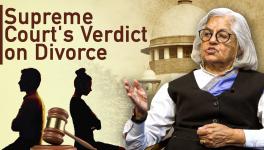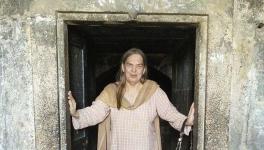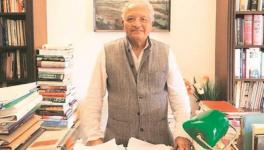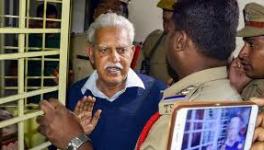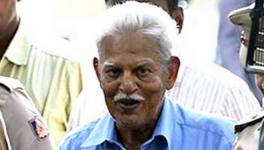‘India Only Seems to Wake Up to Reality When There is an Atrocity’
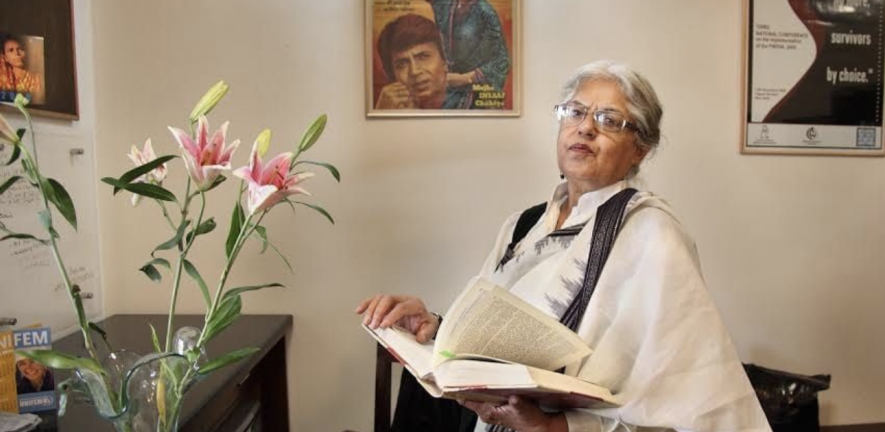
On the 10th anniversary of the brutal gang-rape of a physiotherapy student in New Delhi, human rights activist and senior advocate Indira Jaising looks back at a decade of change
—–
New delhi: With none of her fire and passion dimmed at 82, Indira Jaising is arguably one of India’s most famous women lawyers. She is the first woman to be designated a senior advocate and the first woman additional solicitor general of India.
Her career represents a map of sorts dotted with India’s landmark cases for gender equality. The Sabarimala judgement (Indian Young Lawyers Association vs The State of Kerala) granted women equal access to the shrine where they had previously been excluded. In 1986, she represented Mary Roy (Mary Roy vs State of Kerala) in a case that won equal inheritance rights for Syrian Christian women. In 1999 she was Githa Hariharan’s lawyer (Githa Hariharan vs Reserve Bank of India) in a case that won for mothers the right for children to bear their name.
In one of earliest cases of sexual harassment, Jaising represented IAS officer Rupan Deol Bajaj (Rupan Deol Bajaj vs Kanwar Pal Singh Gill) who brought charges against K P S Gill, then one of the most powerful police officers who Deol Bajaj accused of assault in public at a party.
In 2017, she argued in Shayara Bano (Shayara Bano vs Union of India & ors) that the practice of triple talaq allowed in personal law violates fundamental rights set out in the Constitution. The judgement was a precursor to the legislative ban in 2021 on triple talaq.
Lawyers Collective, the NGO she set up with her husband Anand Grover in 1981 to promote human rights, with a focus on women’s rights and the LGBT community, was instrumental in drafting the 2005 domestic violence law that defined this violence in physical, mental, sexual, and financial terms and provided for a slew of civil reliefs including the right to stay in a shared household.
On the 10th anniversary of the gruesome gang-rape of a 23-year-old physiotherapy student in a moving bus in New Delhi, Jaising spoke her mind on what has changed in the past decade, what hasn’t and what gives her hope in the fight for gender equality and rights. She said she has never forgotten what the student told her mother in hospital: ‘I want to live.’ “It’s a very major turning point in the consciousness of women who are victims of rape,” Jaising added. Edited excerpts from the interview:
We are meeting during the 16-day campaign to end gender-based violence and also, coincidentally, 10 years after the brutal gang-rape and murder of 16 December 2012 in Delhi. I’d like you to weigh in on how much has changed in the past decade.
This country only seems to wake up to reality when there is an atrocity. I would describe what happened in 2012 as an atrocity not just a rape. What I’m noticing [since] is greater and greater numbers of not just rape but gang-rape. The nature of rape itself is changing in this country in the last 10 years. It’s become more aggressive. It’s become more brutalised. It’s become more of a form of vigilantism and gangsterism.
Why is that?
It’s difficult for me to answer that question straight off. Maybe sociologists will have to analyse the phenomenon. But one thing that comes to mind is the prevalence of social media and the easy availability of technology. People think they can mimic what they have seen on television or on social media. It’s almost as if a gang-rape has become an act of valourism. When you and I see a gang-rape, we see brutality, atrocity, sexual violence. What they see is an act of valour But as I said, I’m not an expert. This data will have to be collected.
We have a lot of data with the National Crime Records Bureau documenting the various kinds of violence and crimes against women. The data tell us that the numbers are up year on year. But it’s a bit confusing to a layperson: Is crime actually going up or is it the reporting of it, which perhaps reflects greater confidence amongst women?
I have no doubt that the reporting is going up. There has been a turning point in the consciousness of the women’s movement and even in the consciousness of women who are raped.
One of the unforgettable lines, which I have never forgotten was what the Delhi gang-rape victim said when she was in hospital. She said, “I want to live.” Imagine the contrast from the time when women used to say, “I would like to die of shame, because I’ve been raped.” It’s a very major turning point in the consciousness of women who are victims of rape.
In terms of the incidence of rape, unfortunately, they don’t seem to have gone down; they seem to have become more and more brutal.
It’s ironic, in a sense, because you actually have far tougher laws enacted following the December 2012 gang-rape. Look at where we’ve come from December 2012 to now the Aftaab Poonawala case where you have the chopping up of bodies.
What you’re saying only establishes that increasing punishment does not answer the questions we are asking today. In fact, we argued when the death penalty was introduced for crimes like gang-rape and repeat offenders that what you’re doing is only ensuring that the victim herself is killed because a person thinks, “I’m going to be given the death penalty, so why should I keep a woman alive because she is the only witness to her own rape.”
The more you increase the penalty, the more you increase the danger of (1) the victim being done to death and not surviving to tell the tale. And (2) making it more difficult for judges to convict. We’ve seen the tendency where instead of convicting for rape, judges convict for murder. There are cases where there has been rape followed by murder, but the conviction is only for the murder not for rape. It’s a counter-productive strategy to increase punishment.
Giving in to public demand, there have been dramatic changes in the law, not just with the Criminal Amendment act, but amendments to the Juvenile Justice Act, Pocso (Protection of Children from Sexual Offences). You’ve lowered the age of delinquency, increased the age of consent. In what ways is this creating perhaps problems more than solutions?
We have been arguing that adolescents experiment with their sexuality at 15-16.
When you increase the age of consent to 18, you are criminalising the youth and the adolescents of this country. We opposed it when it was being introduced. Nevertheless, the government of the day thought it was a very progressive thing to do. Now, our judges are waking up to the reality that we cannot put adolescents behind bars. There was a time when they were not even being given bail. This is another example of mindless law-making.
And also perhaps a result of an insistence on infantilizing young women, who we keep calling ‘girls’. Right from the Hadiya case (Shafin Jahan vs Asokan KM) onwards, we say they are not capable; we don’t trust them to be capable of making judgments in their own interests.
Why was the Hadiya case taken to court? Because she converted to Islam out of her own free will and her father wanted to invalidate the marriage which followed after her conversion. It was a horror story to begin with. Then you had a court of law going to the extent of invalidating her marriage on the request of a father. She was an adult, certainly well past the marriageable age and well past the age where she could decide for herself who she wanted to marry.
The issue reached the Supreme Court of India. I was there in the Supreme Court arguing on her behalf. What horrified me was the argument I heard on the other side made on behalf of the father. The argument was that she has been ‘brainwashed’.
Finally, the Supreme Court did deliver a progressive judgement. Even so, she was asked in open court, which was a little unfair: “What do you want?” Her answer was, “I want my religion and my husband.” It’s an unforgettable answer. That’s when the judge said, “Yes, we are convinced that you have converted out of your own free will, and that you want to be with your husband.”
Then she said, “I want to continue with my studies.” She was doing a homoeopathic course at that time and the court said, “Alright, you continue with your studies, but you will stay in a hostel till you complete your studies.” So you see the reluctance to give complete autonomy to women.
I want to pick up on two threads from here. One, is this whole ‘love jihad’ bogey [used for interfaith relationships] that’s actually not a bogey because you have as many as eight states that have laws against it.
I have written extensively about it, but I refuse to use the expression ‘love jihad’. Ironically, these laws are titled ‘freedom of religion’ acts when they are the converse of freedom of religion. The Constitution of India and Article 25 not only guarantees the right to decide on your own religion, but also to practise and propagate it.
I have written in The Leaflet that let’s not call it conversion, let’s call it what it is: When I take to a religion, I’m adopting a religion.
It is my conscious act to adopt another religion or I might be an atheist who might adopt religion. We’ve had spectacular examples in this country of women adopting Islam. A very famous poet in Kerala took to Islam and remained a follower of Islam till she died. We’ve had very famous musicians who have converted to Islam. So why use words like conversion? We adopt a religion of our choice. I strongly suggest that we in the women’s movement stop using the expression ‘love jihad’.
But this goes beyond infantilizing people. It enters the realm of: “Everybody in this country is a Hindu. Hinduism is a way of life. Hindutva is something we need.”
It’s cultural nationalism. It’s not about the Constitution of India. And that’s a whole different debate. It has nothing to do with religion. It’s more to do with the politics of religion.
The second thread I want to pick up on with regard to interfaith relationships is the communalisation of a heinous crime in the Aftaab Poonawala-Shardha Walkar case. I’m coming back to it because it is so recent and it actually shocked me that there was only one issue in this case–intimate partner violence–that was was hijacked by all kinds of interpretations of moralistic tales: Interfaith marriage karoge toh aise hoga; if you go against your parents’ wishes, then this is going to happen to you. So how do we bring the focus back to domestic violence?
I really can’t answer your question because it’s got a lot to do with the media and the way television presents the narrative to us. We’ve become consumers of the media. Tamashas, rather than having the media inform us about what’s going on around us.
In October 2023, the Protection of Women from Domestic Violence Act of 2005 is going to complete 15 years. The law was passed in 2005 and was brought into force by the President of India on 26 October 2006. It is perhaps one of the few anti-discrimination laws this country has enacted, which applies to private actors. When I say private actors, I mean the intimate partner that we are talking about, be it a husband or live-in partner.
What the act does is define violence to include economic, psychological, sexual and mental violence. The whole idea was to understand violence not only as an act of physical violence, but something that happens on a daily basis within the four corners of the shared household.
We also defined the household no longer as a matrimonial home, but as a shared household because the intention was to protect not only the married woman, not only the live-in partner. Very often Indian families are not nuclear but joint families. The violence can extend to the daughter of the house, the mother or every woman who lives within the framework of what we call the shared household.
But you’re right in saying that society has not yet recognized that domestic violence in its various forms is not only an epidemic, it might even be a pandemic. When I travelled the world, I saw how other countries have dealt with it through law, whether it’s civil law or whether it’s criminal law. Here we have the law on paper and we have this law being completely ignored.
Why is that and in what ways?
The state plays a big role in the enforcement of laws: By the endowment of infrastructure; by creating adequate number of courts which women can access; by judges who are sensitised to the issue of domestic violence; by police sensitised to the issue.
In this country, we have a vibrant women’s rights movement. We’ve got at least 25 years of experience of women’s groups servicing women who face domestic violence. In this law we created a niche for them.
There are three major differences in this law compared to other laws which came before it. One, there is a place for service providers, they are defined and they are the very same NGOs who have been working on the issue of domestic violence.
There was a place for state-appointed protection officers. [But] no state has created a good cadre of protection officers in 14 years. They’ve made bureaucrats, tehsildars and government officers double up with these duties. Some states did make a massive effort to sensitise the police. Andhra Pradesh had a very progressive commissioner of police at one time and he took the trouble to sensitise the police force.
The second thing is that we gave women an option, a civil option, to get away from the criminal law. Why? Because this is a preventive law. It’s meant to be accessed by women before they suffer the final ignominy, whether it is being beaten up or being killed.
It’s an amazing law, but the tragedy is that it has not been strengthened with the necessary infrastructure. Civil society has not been allowed to play a critical role in helping women. After 2012 we have seen some talk. A fund was created and we have seen the establishment or the proposed establishment of one-stop crisis centres, which are supposed to provide under one roof counselling, police services, legal services and shelter. Every district is supposed to have one such centre. It’s obviously not enough because you could be living very far away from a district headquarter. The Nirbhaya Fund is not spent. There is unspent money lying in the coffers of the government of India that was meant for these purposes.
There is a perception that crimes against women happen when they step outside of their domestic boundaries. But the data tell us very emphatically that the home is not the safest place, that one in three women faces violence from a family member. This is a crime in plain sight. There is very little intervention. Why is that?
You’ve hit the nail on the head. Except that it is not a crime in plain sight. It happens behind closed doors. I have dealt with cases where women have wanted to reach out but have literally physically been prevented from going to make a complaint.
What you are talking about is the narrative in the public domain: “This happens because you step out,” is what women have been calling ‘myths’. I prefer to call it the backlash. It’s more than a myth. It’s a narrative intended to push women back into the home. The more you see women in the public domain, whether in positions of working women or whether they are in the service sector, whether they are in the courtroom appearing as lawyers. There’s a lot of discussion on the attire of women lawyers; never any discussion on the attire of men.
Shorn of its trappings, the argument is: Go back home. In my own life I have seen that the more ‘successful’ you get, the more experienced you get, the more you advance in your career, the greater the discrimination you will face.
Did you face it? Would you like to talk about it?
Yes, I did. I haven’t understood it fully as yet but I think it manifests in the form of exclusion. As working women, we don’t really believe in networking in all male networks. Networks are still all male. It’s no fun being in those meetings. There’s also a difference between networking, which is more like a business thing to do, and being vested. I’m vested in my work, but I’m not networked in my work. This results in all kinds of exclusion, which then have a negative impact on you psychologically and in every other sense of the word.
As a woman, you will be protected. But dare to have a voice of your own, and you will suffer.
I’m going to come back to this issue of networking in the context of the #MeToo movement in just a second because I feel we’ve gone a little off track. I want to come back to domestic violence. A very fundamental question that is often asked by men in particular: Why didn’t she walk away? Shraddha Walkar knew she was living with a violent man so why didn’t she walk away?
It is an important question. A bit difficult to answer, but you need to understand the nature of an intimate relationship, whether it’s with a husband or a sibling or a father or a mother. The word ‘intimate’, what does it indicate? It indicates an emotional bond, a shared history, living and sharing together.
In this situation, the realisation that you are being exploited or that somebody is being violent towards you takes a long time to come. Coupled with that, there is the hope that things will improve one day. There is also the phenomenon of what sociologists have called the cycle of violence where an abusive spouse will suddenly turn very affectionate towards his partner in an attempt to keep the woman under his control. They fear the women leaving the four corners of the house. And they certainly don’t see violence as a crime.
There is data that show I think 52% of women believe that a beating by a husband is justified if a meal is improperly cooked or if children are being neglected.
I have doubts about that data. I don’t know how it’s been collected. But let’s assume that there would be some women, certainly not a working woman or women who are exposed to the real world outside the home, who might justify it. But that’s not really the problem. I’ve seen in the courtroom how judges, after dealing with a very violent relationship, say things like: “Now touch his feet and go home.” If this is the attitude to violence against women, can you blame them for not accessing the law?
Only 14% of women who face domestic violence will tell anyone about it. Forget about the police, they don’t even tell family members.
Most women know that there are women’s groups and organisations especially in urban centres. As I told you earlier, the women’s movement has made strides in that matter.
The problem really is with state-mandated agencies. I want to tell you about a case, which I dealt with very early, almost 15-20 years back, where a woman came to court seeking relief. The only thing she asked for was custody of her child. So, that’s the other issue: Women don’t walk out of the home because they are afraid of losing custody of the child.
This woman had left the home but came back repeatedly to the court asking for custody of her child. Of all things in the world, her husband was a dealer in kerosene. In one of the hearings, the judge said, “Why don’t you go back to the house and try this out?” Only out of love for her son she went. The next thing I heard is that she had died by being burnt with kerosene. Nobody was even willing to acknowledge that this could have been murder. The husband said, “Oh this was an accident.”
Would you add or take away something from this law, if you had to rewrite it?
I would empower women groups. The other very important thing is that it also created medical facilities as service providers, which means that if any woman were to access a medical facility, they would be bound to provide her with relief.
In Mumbai, spectacular work was done in Bhabha hospital. There was a project known as Dilaasa, housed in a hospital where all the doctors were sensitised in how to deal with a victim of domestic violence. The project showed results.
We now have multiple best practices. They should be formalised and made mandatory. These are the people who need to be brought on board to help a woman facing domestic violence. When Shraddha Walker was asked by the doctor, “Why do you have this injury?” She said, “I had a fall.” It’s a standard answer of a woman facing domestic violence.
Well, yes. She made a police complaint. She told her friends. Her employer knew. It was not a secret. That’s why I said it’s hidden in plain view. We choose not to look.
Yes, it is the failure of civil society. Also, the marital family plays a big role. When a woman faces a problem within the matrimonial home, it’s only her family she goes back to. Now if that family is going to tell her, “You don’t come to us,” where is she going to go? How is she going to have the confidence that a one-stop crisis centre will help her or a women’s organisation will help or that she’s going to be able to find a job?
What I would like to see is a policy enacted by all employers to support women working in their organisation who face domestic violence. First, they will have a counsellor in office to whom a woman can talk freely.
When we get orders for financial relief for women from courts, it’s impossible to execute that order. I would like to see employers coming on board and saying, “Look, we’ll deduct from the salary and give it to the wife.”
There are multiple ways of helping people if you want to. The will is lacking.
I want to come back to something we touched upon a short while ago. Networking. We saw the price of that sometimes paid by women during the MeToo movement. When it erupted, the movement was full of energy and gave hope for change. But unlike in the West, where there was accountability, very little actually changed in India. Systemically, this culture of exclusion and discrimination hasn’t fundamentally shifted. Men have responded with criminal defamation suits. Many have been rehabilitated with cushy jobs. They’re on television giving lectures on prime time debates. Why didn’t the needle shift?
Take the United States of America. The legal system works over there. So, when you take a case to court, you have a reasonable chance of success. In India, I see two problems. One, we are a stratified society. Hierarchy is the norm. The way these atrocities or this harassment occurs, there is almost always a hierarchical relationship. We’ve had an example in this country of a chief justice being accused of sexually harassing an employee. It doesn’t concern me whether the relationship was consensual or not. What concerns me is that it happened at the workplace.
There are no equal workspaces. There is no equality at the workspace in terms of hierarchies. That’s one reason why we have not been able to get a lot of success in the MeToo movement.
The other is a certain dysfunction. The functioning of the Indian legal system is almost moribund, apart from the fact that it’s too expensive to access. All this has a completely chilling effect on women who might even consider going to court. The distribution of legal resources is so skewed. How many people want to represent a woman who has faced sexual harassment against a powerful media baron, a powerful judge, or a powerful employer?
In the United States of America, these suits are routine. There is also what I call a culture of settling an issue. I have handled the case of an Indian woman who faced sexual harassment from her boss. Fortunately for her, the company was a multinational headquartered in America. I was surprised when after she lodged a complaint, the legal officer of the company, who happened to be a woman, asked her to put her in touch with her lawyer. She also said: “Just share with me, under conditions of confidentiality, the evidence that you have against this man who was the MD in India.”
So she shared those WhatsApp messages. The officer flew down to India and took a decision to advise the company to sack the managing director. The case didn’t even go to court.
Then they settled with her, her own demands. She wanted rehabilitation, a job in another branch of the company in another country. All that they agreed to. I’ve had other cases of this kind. In India, what do we do? We sit and litigate till the cows come home.
And of course, litigation itself is a privilege, given that 95% of women work in the informal sector and have no access to courts and lawyers.
The informal sector is a completely different ballgame. It’s only thanks to people like Ela Bhatt who organised women in the informal sector that they found a voice in relation to their social and economic issues.
Eventually cutting across class, caste, community religion, socio economic status, what women want is justice. Yes, going through due process is painful. But ultimately till we find a better way, it is the only thing.
You are so right. Sometimes what a woman wants when it comes to justice, is just simply an acknowledgement and an apology that is not forthcoming.
Looking back at your career as a lawyer, what are the significant milestones? What are the cases close to you?
I will tell you about this ordinary case of a woman facing domestic violence. Her husband was a politician and in a position to dominate her. It was difficult for her to get a decent separation. All I did was represent her and got a separation, and she got a divorce.
At that time, her daughter was no more than nine years old. You wouldn’t believe it. I met this daughter very recently. She went on to become Miss India. Her mother is so proud of her. And so am I. She came to see me recently and said, “I just want to spend a little time with you. That’s all I want.” Then she told me, “I would accompany my mother when she would come to see you. My mother was so afraid of you and she would tell me, ‘Look at Ms Jaising, she is so aggressive in her interaction with me’.”
And this little girl would tell her mom, “But when she talks to me she’s not like that.” She told me that she was actually influenced by the way in which I was handling mother’s case. I was very pleasantly surprised to see that she had a head on her shoulders, and was not gathered away by the euphoria or by the media glare. She was just another normal woman.
If you ask me for the highlights of my career, it’s going to be very difficult to answer saying it was Sabarimala or Shayara Bano. These were very exciting cases. But at the end of the day, it’s just about that one person whose face I can still see and who says I’m leading a better life because your life is an inspiration.
What gives you hope?
I believe in the law. I believe in the rule of law. Regardless of what people may say about courts being corrupted and the executive dominating the judiciary, I believe in myself, and in my ability to articulate the values of the Constitution.
I came of age when the values of the Constitution were part of our everyday life. I’ve grown up with people around me who used to talk about those values. This was what I chose for my career. It keeps me going till today.
This interview, jointly hosted by Article 14 and The Leaflet, was conducted on the occasion of 16 days of activism against gender-based violence. The interview was first published on Article 14.
Namita Bhandare is a Delhi-based independent journalist who writes on gender issues.
Get the latest reports & analysis with people's perspective on Protests, movements & deep analytical videos, discussions of the current affairs in your Telegram app. Subscribe to NewsClick's Telegram channel & get Real-Time updates on stories, as they get published on our website.











